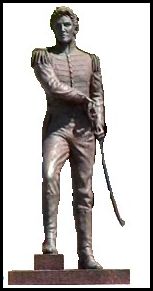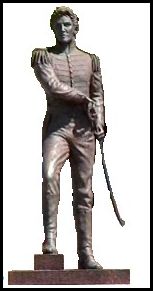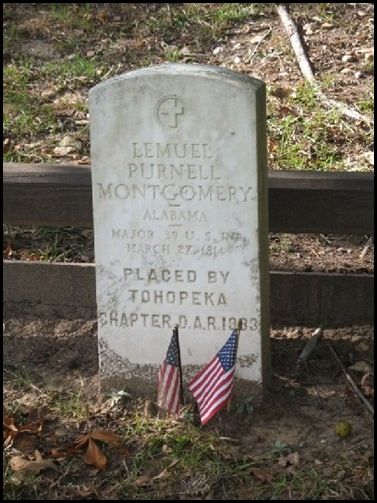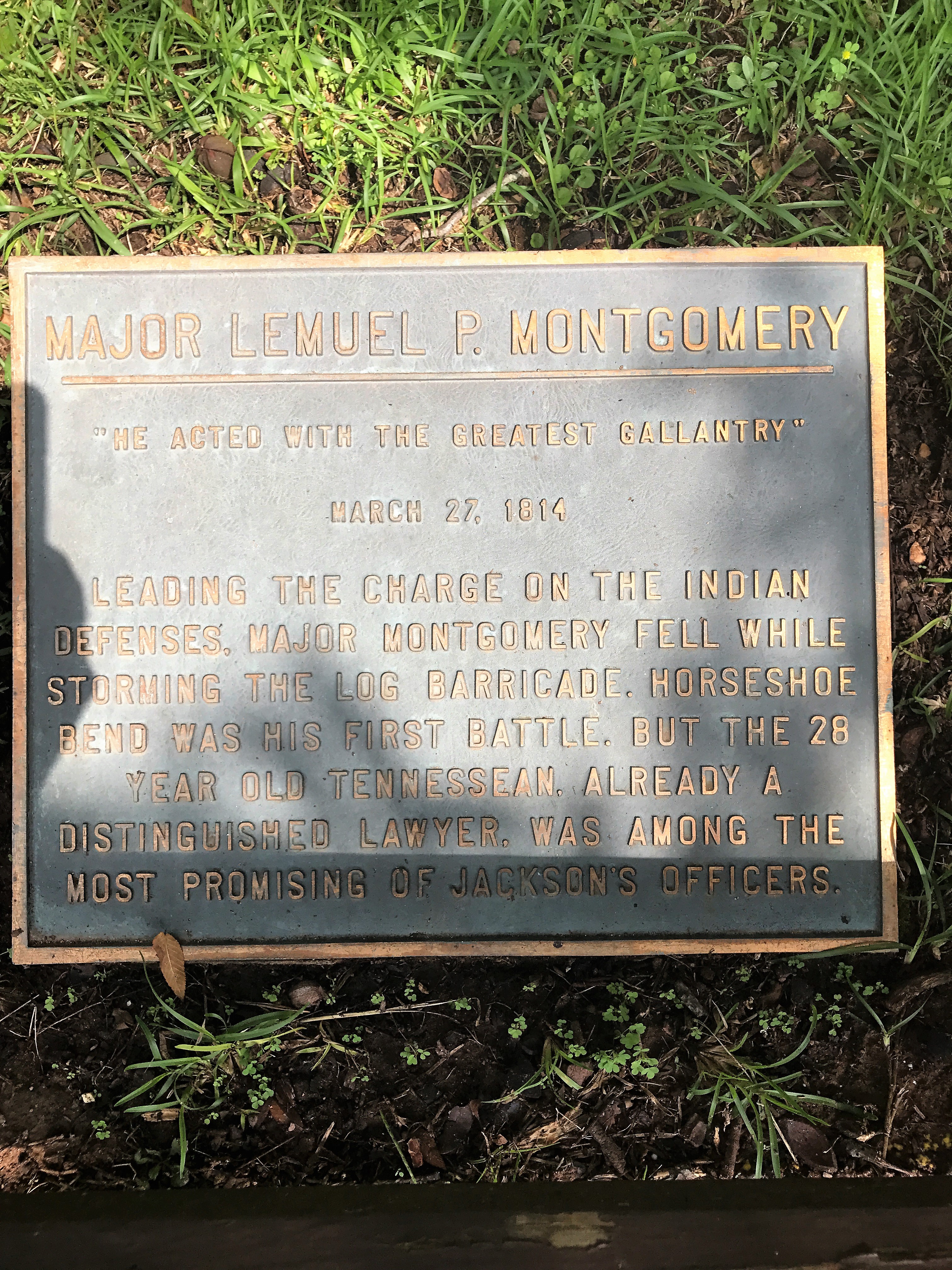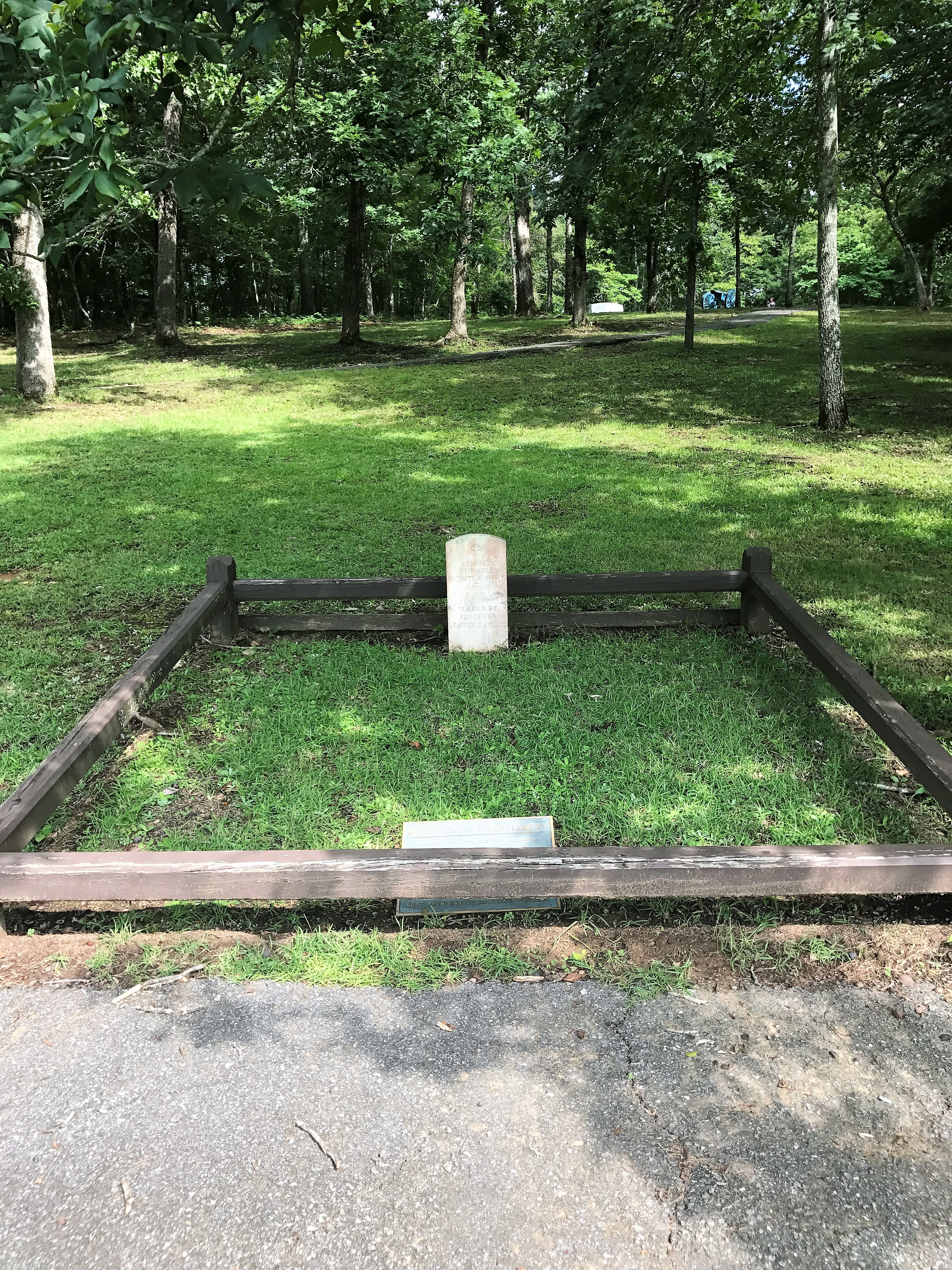He was one of the first Americans killed in the Battle of the Horseshoe Bend in the War of 1812.
On March 27, 1814, Andrew Jackson, with a force 3,300 men consisting of Tennessee militia, United States regulars, and both Cherokee and Lower Creek allies, attacked Chief Me-Na-Wa and 1,000 Upper Creek or Red Stick warriors fortified in the "horseshoe" bend of the Tallapoosa River. The Red Sticks were trapped and slaughtered, ending the Creek War. In the treaty that followed, the Creek lost twenty million acres of land, half of all they claimed.
http://americanhistory.si.edu/militaryhistory/printable/section.asp?id=3
When the battle was ended, Jackson stood over his body and wept. He exclaimed "I have lost the flower of my army."
At the time of his death Major Mintgomery was only 28 years of age. His eyes were keen and black, his hair was of a dark auburn color, his weight was 175 pounds, his height was 6 feet and 2 inches, his form was admirably proportioned, and he was altogether the finest looking man in the army."
Andrew Jackson and early Tennessee history ... By Samuel Gordon Heiskell, John Sevier
--------------------------------------------------------
The following was provided by Don Clark of LaFayette, AL. He is related to the McIntosh family.
"The LaFayette Sun - April 19, 1905:
A Hero’s Grave.
Dudleyville, Ala., March 19, 1905.
Editor – The Advertiser:
There has been a number of inquiries in regard to the exact location of the grave of Major Montgomery, who was killed at the battle of the Horseshoe Bend; and later on, his remains were removed to this place. After the recent cold weather and rains, a place sank down in the front yard of Mr. A. H. McIntosh. Tradition says that Major Montgomery was buried in that yard; but there was not a thing to mark the grave. Some old citizens said the grave was at the east end of the yard, others said, it was in the front yard. The cracked place in the earth was in the walk from the grave to the door, ten feet from the gate and fifteen feet from the veranda steps. Mr. J. A. Hoyle, Mr. A. H. McIntosh and myself dug down into the place and soon found it to be a grave. We dug on to the bottom and found the bones of a human skeleton; many of the bones crumbled as soon as they were touched. The bones best preserved were the two femurs, clavicles, superior maxillary, humerus, teeth and portions of the skull. Tradition says that Major Montgomery was the only person buried anywhere about the place; so the remains are undoubtedly those of the brave Major. The Alabama Historical Society and a Monumental Association have made several efforts to obtain some information in reference to this grave. Mr. Hoyle, Mr. McIntosh or myself will cheerfully give any information we can on this matter.
Yours truly – W. G. Carleton.
He was one of the first Americans killed in the Battle of the Horseshoe Bend in the War of 1812.
On March 27, 1814, Andrew Jackson, with a force 3,300 men consisting of Tennessee militia, United States regulars, and both Cherokee and Lower Creek allies, attacked Chief Me-Na-Wa and 1,000 Upper Creek or Red Stick warriors fortified in the "horseshoe" bend of the Tallapoosa River. The Red Sticks were trapped and slaughtered, ending the Creek War. In the treaty that followed, the Creek lost twenty million acres of land, half of all they claimed.
http://americanhistory.si.edu/militaryhistory/printable/section.asp?id=3
When the battle was ended, Jackson stood over his body and wept. He exclaimed "I have lost the flower of my army."
At the time of his death Major Mintgomery was only 28 years of age. His eyes were keen and black, his hair was of a dark auburn color, his weight was 175 pounds, his height was 6 feet and 2 inches, his form was admirably proportioned, and he was altogether the finest looking man in the army."
Andrew Jackson and early Tennessee history ... By Samuel Gordon Heiskell, John Sevier
--------------------------------------------------------
The following was provided by Don Clark of LaFayette, AL. He is related to the McIntosh family.
"The LaFayette Sun - April 19, 1905:
A Hero’s Grave.
Dudleyville, Ala., March 19, 1905.
Editor – The Advertiser:
There has been a number of inquiries in regard to the exact location of the grave of Major Montgomery, who was killed at the battle of the Horseshoe Bend; and later on, his remains were removed to this place. After the recent cold weather and rains, a place sank down in the front yard of Mr. A. H. McIntosh. Tradition says that Major Montgomery was buried in that yard; but there was not a thing to mark the grave. Some old citizens said the grave was at the east end of the yard, others said, it was in the front yard. The cracked place in the earth was in the walk from the grave to the door, ten feet from the gate and fifteen feet from the veranda steps. Mr. J. A. Hoyle, Mr. A. H. McIntosh and myself dug down into the place and soon found it to be a grave. We dug on to the bottom and found the bones of a human skeleton; many of the bones crumbled as soon as they were touched. The bones best preserved were the two femurs, clavicles, superior maxillary, humerus, teeth and portions of the skull. Tradition says that Major Montgomery was the only person buried anywhere about the place; so the remains are undoubtedly those of the brave Major. The Alabama Historical Society and a Monumental Association have made several efforts to obtain some information in reference to this grave. Mr. Hoyle, Mr. McIntosh or myself will cheerfully give any information we can on this matter.
Yours truly – W. G. Carleton.
